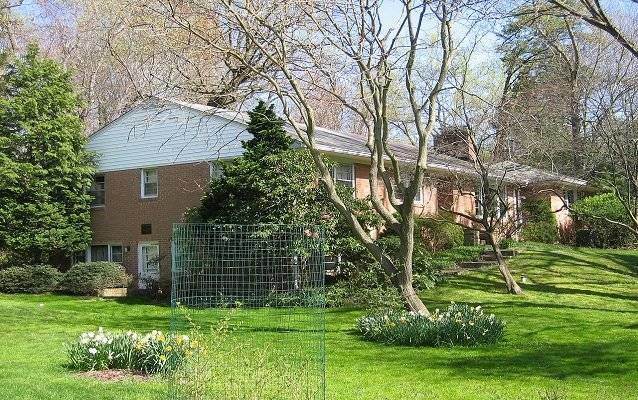Last updated: July 28, 2021
Place
Rachel Carson House

In 1962, American biologist, naturalist, and writer Rachel Carson wrote the acclaimed book Silent Spring at her home in Silver Spring, Maryland. Through her dedicated research and brilliant command of the English language, Carson uncovered the moral and physical consequences of the indiscriminate use of pesticides. Her seminal book spurred a nationwide reversal pesticide policy, including the ban of DDT. Carson’s tireless advocacy changed the way Americans viewed the environment by encouraging an improved relationship between man and nature. She sparked the modern environmental movement.
Born in 1907, Carson grew up on a farm in Springdale, Pennsylvania. Her parents encouraged her exploration of the natural world and pursuit of education. From an early age, Carson displayed natural writing talent. She entered Pennsylvania College for Women to pursue a degree in English. In her junior year, she switched majors to become one of three students to study biology. Private and reserved, Carson worked diligently and graduated with honors in 1929. She went on to receive a Master of Science, with a focus on zoology and genetics, from Johns Hopkins University. She then taught at Hopkins and at the University of Maryland.
In 1936, Carson began her career with the Bureau of Fisheries (later the Fish and Wildlife Service). Her boss tasked her with writing scientific pamphlets for public consumption—a job she enjoyed for it combined her talents of writing and biology. While working for the federal government, Carson wrote her first book, Under the Sea-Wind, a natural history of the ocean, in 1941. For sixteen years, Carson moved up the Department of Interior chain of command.
By 1949, she was Editor-in-Chief of all department publications, at that time a remarkable feat for a female scientist. Carson completed her second book, The Sea Around Us, in 1951. The book garnered instant popularity and respect. The New Yorker serialized the publication and it remained on The New York Times bestseller list for months.In 1952, she resigned from her government job and bought a cottage in Southport, Maine. From here she conducted original research on tidal pool ecosystems. Her third publication, The Edge of the Sea, written in 1955, ended her anthology on the natural history of the ocean and solidified her standing in the intellectual world.
In 1956, Carson moved into her new home in Silver Spring, Maryland. She designed her asymmetrical one-story brick house to fit in with the natural environment, only slightly altering the surrounding landscape. She planted several evergreen trees and intentionally worked to create a natural wooded area.
In 1958, Carson began work on Silent Spring, which was published in 1962. Carson concentrated her new book on mankind's destruction of nature. Silent Spring revealed the interconnectedness of all living things. For example, pesticides applied to trees ran off into cow pastures, eventually contaminating human milk supply. Carson criticized scientists for endorsing the wholesale use of destructive pesticides, including DDT, despite poor results and harmful side effects to the environment. She did not advocate for the complete abandonment of pesticides, but a more conscientious approach. Carson opened America’s eyes to the long-range effects of human deeds on nature and, ultimately, themselves.
Silent Spring caused an immediate reaction. The chemical industry spent hundreds of thousands of dollars in an attempt to discredit Carson. President Kennedy created the Presidential Science Advisory Committee to investigate Carson’s thesis. The committee verified her arguments and acknowledged her work in bringing pesticide abuse to light. Silent Spring sold over 600,000 copies in 1962. Many credit Carson’s work as the catalyst for the creation of the Environmental Protection Agency in 1970.
On April 14, 1964, Carson died of cancer in her Silver Spring home. The new owners have retained much of Carson’s original construction, including the mirrored shelves that held her shell collection. Her home currently houses the headquarters and library of the Rachel Carson Landmark Alliance (RCLA), a non-profit organization devoted to preserving Rachel Carson’s legacy, including the house where she wrote Silent Spring. Through her clear poetic prose in Silent Spring, Carson sounded an alarm that forced the American public to think critically about the dangers of uninhibited chemical use. Carson's house serves as a reminder of her hard work to alter human interaction with the environment. Four years after her death, America celebrated its first Earth Day.
Sources:
Lear, Linda J. “Rachel Carson’s ‘Silent Spring.’” Environmental History Review 17, No. 2 (1993).
Lear, Linda. “The World Took a New Direction: Rachel Carson’s Legacy.” History News 52, No. 3 (1997).
Lewis, Victor. “Rachel Carson Remembered.” Race, Poverty & the Environment 2, No. 1 (1991).
Sideris, Lisa H. and Kathleen Dean Moore, eds. Rachel Carson: Legacy and Challenge. Albany, NY: State University of New York Press, 2008.
National Historic Landmark Nomination of the Rachel Carson House.
National Historic Landmarks (NHLs) are historic places that possess exceptional value in commemorating or illustrating the history of the United States. The National Park Service’s National Historic Landmarks Program oversees the designation of such sites. There are just over 2,500 National Historic Landmarks. All NHLs are also listed in the National Register of Historic Places.
